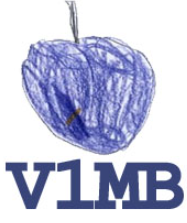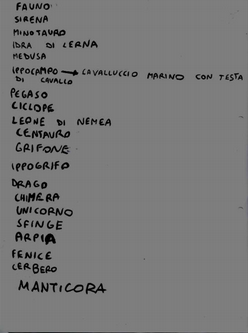
Avatar, courtesy of V1MB – son of the blogger first drew the blue apple and then he gave it to her to create the blog icon (Information sent by V1MB).
Voglio Una Mela Blu (V1MB)
, b. 1975
The real name is known to Dorota Bazylczyk (University of Warsaw) but V1MB prefers to remain anonymous.
“Ever since 1975, when she was a small girl, Vogliounamelablue looks at the world through her blue eyes; from 1975. And not much later, she realizes what interests her the most: people and their stories. And so, starting with a classical education, she attempts later to weave this thing into a profession that allows her to combine it also with a family – psychiatry. Today, thanks to Heaven, she has a job, a husband, and two kids. In her home studio she has a six-door wardrobe filled not with clothes but with paints, brushes, decorated cards, old rags, ribbons, scissors, glue, solvents and, in short, her blue apple.*"
The blog's title was based on the title of the book Voglio una mela blu, written by Ibi Lepscky, illustrated by Luciana Roselli, published in 1973 by Einaudi (volume 24 in the TANTIBAMBINI series, a collection directed by Bruno Munari). Vogliounamelablu explains that the book was “not her favourite volume of TANTIBAMBINI but, in a sense, an inspiration.**”
* Biography sent by V1MB.
** The official biography of V1MBl (accessed: July 6, 2018).
Sources:
Biography sent by V1MB.
Facebook fanpage (accessed: July 6, 2018).
Bio prepared by Dorota Bazylczyk, University of Warsaw, dorota.bazylczyk@student.uw.edu.pl
Questionnaire
1. What drew you to work with Classical Antiquity?
First I just received a proposal from my friend Sybille. Then I began to fantasize. I talked about it with my family and suddenly a considerable amount of images, references, stories and evocations that had remained in my and my children’s memory and imagination emerged. I thought to myself – why not create something of our own, to give a new shape to this material?
2. Do you have a background in classical education (Latin at school or classes at the University?)
Yes, before the University I attended a classical high school for 5 years, where I studied the languages and cultures of Rome and ancient Greece. Then I studied Latin and ancient Greek, translating historical and rhetorical texts and reading passages from the Iliad and the Aeneid (appreciating the pace!).
3. Why do you think classical/ancient myth and literature continue to resonate with young audiences?
I think they are still fascinating for young people because they constitute an enormous cultural heritage that tells about world full of fantasy, adventures and incredible stories. Narrated stories are often dramatic and passionate, there are also some scary figures and heroes with whom young people identify willingly, following values sometimes very far from our recent tradition.
In Italy we live in direct contact with reflections of these cultures, in architecture and language, in the names of people; it is enough to look around, or go find the etymology of words to see everywhere traces of ancient Greek and Roman cultures. Children naturally curious, love this kind of "treasure hunt"!
4. What is the main idea of your project Mischiamiti?
The main idea of the project Mischiamiti was to create materials to play and learn with a mythological theme that could be accessible to audiences of different age groups. The game-book is suitable also for young children of preschool age because it can be coloured and you can play with it, mixing different patterns. For children who have just learned how to read, it’s entertaining to read and see how the names of "mythological monsters" can change and mix. On the other hand, rhymes are challenging to older kids because they contain rare words and you can play mixing verses; they can be also amusing for adults who catch ironic references to myths and appreciate the poetic allusions. It was so much fun to offer to the readers of our blog (and of course to our friends and family) the game which consist of composing rhymes based on a regular scheme, so they could be mixed without any problems; in this sense the book is "collaborative” because among the known rhymes there are some composed by our readers! All rhymes were composed in the “participatory” phase – then they were collected in a small publication. In order to appreciate Sybille’s designs we also created two sets of cards, which are easily downloaded, printed and used. By printing two copies of selected cards you can play a memory game – one of the first card games that could be offered to children. To practice reading and writing you can use one copy of cards with names and one copy of cards with small biographical stories of each (unnamed) "mythological monster": after reading each story you can guess which monster was described and match the cards, and also write the name of "mythological monster" to which it refers.
With this version my children have also played in a group of friends! One child read the anonymous biography and the others (watching all the picture cards) had to guess the corresponding drawing: the first child that touched the right card, won it; the overall victory belonged to the child who got the largest number of cards. We also thought about a version of cards to be printed front / back in order to create – for the older kids – a "collection" of characters from Greek and Roman mythology reproduced on one side and described on the other.
5. Why did you decide to work with mythological creatures? (And why did you choose these specific figures?)
The initial suggestion to create the cards portraying mythological figures came from Sybille, October 1, 2016. (We live in two different cities which are far away from each other and we work together chatting on the internet, so it’s easy for me to reconstruct the whole story of this project, thank goodness!). The idea met with huge enthusiasm from my family: we chose these mythological figures because those are the ones that have been suggested by my children (age: 6 and 10), based on their passions and knowledge. My children know different stories about Greek myths because they have read or seen books on this subject and because I gave them as a present the first version of cards with mythological monsters (but those cards were very "scary" for them so they wanted to throw them away). We were all curious about how Sybille would be able to draw these characters in a recognizable way, but "brighter" and funnier. Reproduced below is the list written by my eldest son, after the family brain-storming, which became a basis for Sybille to start drawing. Names were then grouped into categories, and therefore better suited to the specific format of a game-book.

6. What challenges did you face in representing/describing these figures/characters/ myths?
As for the representation of characters, I have worked on the drawing up some rhymes and writing short biographies. As a reference for narrative texts I used the information I found on the respective pages (in Italian and English) of Wikipedia, producing a synthesis and trying to make the text consistent and homogeneous. Furthermore, I often address myself directly to the reader - involving the reader in the observation of the proper illustrations, I invite the reader to make judgments and to go deeper into the details of the myths, which are only mentioned in the biographies.
In the case of rhymes, on the other hand, I worked more freely and I had a lot of fun playing with the serious and established image of the myths, transmitted from classics and how they came to me, and treating them a bit differently. For example in writing the rhyme about the poor phoenix, I've imagined that the bird was distressed, because there was too much dust rising from the ashes, and I laughed a lot.
I had major difficulty with the names of the characters which are composed of difficult sounds - it was not easy to build perfect rhymes within the rigid grammatical structure imposed by this type of rhymes!
7. Why did you decide to use game format – book game, cards?
We have just released a multilingual card games exploring the characters of Halloween tradition. Sybille’s proposal to create mythological theme cards came from the desire to produce more comprehensive materials, sacrificing "internationality", but allowing them to integrate the levels of the game and the images with the Italian tradition of writing rhymes for kids (my husband, who wanted to contribute by writing a lot of rhymes, was clearly inspired by the famous Italian author - Gianni Rodari). Perhaps this has been the most innovative part of the project, from my point of view: the book format and the idea of "modular" rhymes was born after a search of similar experiments already produced, which then were adapted and customized to our specific needs.
(I wrote about it here!)
Sybille works with innovative teaching methods and I have a great fascination and interest in illustrations and paper products applied to literature and games for children and teenagers. Both of us know - from our respective expertise – that the multimodal stimulation is the one that leaves a mark in the memory and most easily gets people interested, because it engages and connects more senses and more types of intelligence.
All the material lends itself to reading aloud; drawings in black and white can be coloured as desired; cards can be handled, counted, combined, written. Our proposition can create motivation to study the themes used in greater depth thanks to the ludic format but also to the added narrative aspects.
8. Are you planning any further forays into classical material?
Sybille is a volcano of ideas and proposals carried out independently or in various collaborations. I, in view of my studies, am particularly fond of the classical tradition, so I’m absolutely open to new projects in this sense. However, for now we are still exploring further possibilities for the Mischiamiti project, in particular and in terms of innovation, we are considering a digital version, which makes the game-book immediately usable even for those who cannot or are not able to print and "mount" the paper version. We are also looking for volunteer translators to offer small samples of the cards in other languages (more widely known than Italian!).
Prepared by Dorota Bazylczyk, University of Warsaw, dorota.bazylczyk@student.uw.edu.pl
Records in database:


